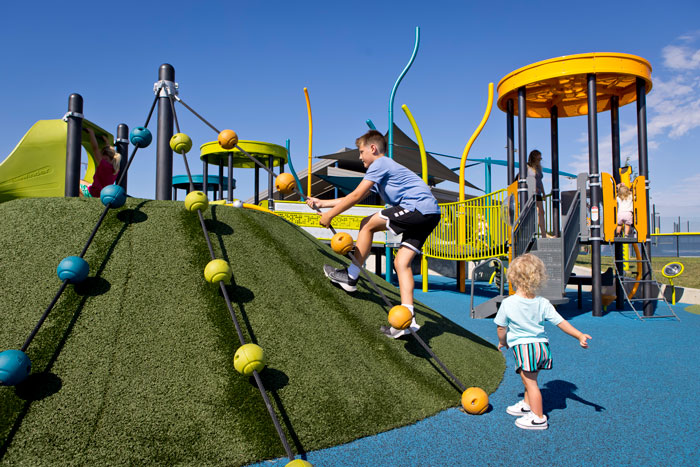Trends in the development of playground equipment and how playground spaces are designed are a reflection of advances in the understanding of children’s physical and cognitive development through play. Those factors are key to understanding the evolving role that playgrounds have in communities, where municipalities and school districts are spending public and private funds for new, more spectacular and more inclusive playground equipment.
Of course, the playground space and equipment always has to appeal to children. But then, along came the pandemic in 2020, when the importance of outdoor playgrounds for multigenerational play was magnified even further.
“At the start of the COVID-19 pandemic, especially in urban areas, people started to realize how important parks and playgrounds were—to be at least outside. If you couldn’t be within six feet of someone, you were out in nature,” said Scott Roshi, creative director for a playground equipment manufacturer based in Delano, Minn.
During the height of the pandemic, Roshi added, communities started realizing what valuable assets they had in public parks and playgrounds. “This led to a heightened awareness of playgrounds in general. We’ve seen a desire to truly provide spaces that serve the community in a much better way to fight against their electronic devices. Getting kids outside and keeping them active has been a big part of that.”
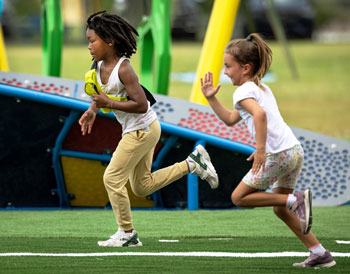
Through all these challenges, equipment manufacturers and their teams of designers have produced innovative and fun approaches to play. Creating places for people to gather outdoors and even moving some activities that have traditionally been done indoors—exercise and learning are examples—to the outside makes it easier for everyone to get the benefits of time spent outside, said Sarah Lisiecki, communication and education manager of a playground equipment manufacturer in Fond du Lac, Wis. “Outdoor fitness equipment that engages different ages and fitness levels is one way to get the entire family (ages 5 and up) exercising. Then too, you have to think about demographics, different ages, and even having to account for older folks who bring their grandchildren to playgrounds.”
Play equipment geared toward people of all ages and stages of life is a trend Lisiecki has noticed. “We see communities embracing and creating spaces to support the diverse population of the areas they serve. People of all ages and abilities need to be outdoors for mental and physical health, studies show.
“Creating playgrounds as gathering spaces that provide entertainment for everyone gets the most support and encourages community pride and engagement—two important benefits of public playgrounds and greenspaces,” Lisiecki added.
More & More Inclusive
Inclusion is certainly a trend that has been around for quite some time. From the Americans With Disabilities Act (ADA), which became law in 1990, to universal design, an inclusive playground or outdoor recreation space is simply considered good design. But inclusion means more than simply providing better access for visitors with wheelchairs.
“Oftentimes,” Lisiecki said, “when we think of inclusive play, we think of access for people using mobility devices. This is an extremely important factor, of course, but there is more to inclusion, and we’ve been seeing the definition of inclusion expand to include a variety of different abilities and preferences. Children like to have control over their play experience, but all too often, children with mobility differences don’t have as much of an opportunity for this as other children.”
Designing a space that includes events that allow children to get into and operate the play event themselves is important and helps everyone have the opportunity to control their own play to build confidence, Lisiecki noted.
Group play is important for social development, said Anne-Marie Spencer, vice president, marketing for a Chattanooga, Tenn.-based equipment manufacturer, “and the impact of the physical environment on the social integration of individuals with disabilities can be profound if not designed for all.
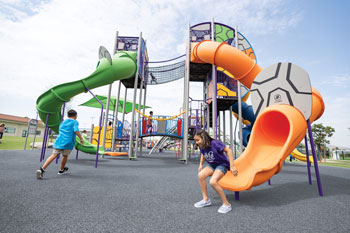
“Inclusive playgrounds are much more than choosing colorful play components and connecting them to ramped inclines. A great inclusive play space provides access, promotes inclusive play between children of all abilities, and develops the whole community, whole environment and whole child—across all developmental domains.
“When we can provide children and families with inclusive environments that promote playing together more independently,” Spencer continued, “children feel respected, nurtured, encouraged and active during play. It’s also important to remember that disability comes in many forms. Yes, it describes people who use mobility devices, but there are also people with vision, hearing, learning and many other disabilities. We focus on creating inclusive environments, where all children find opportunities to participate in play to secure the health benefits of physical activity, the developmental benefits of play and the social benefits of inclusion, to the greatest extent possible.”
Going Intergenerational
Inclusivity also encompasses the concept of intergenerational play, which is also a trend, said Lisiecki and Roshi.
“The more people that can use the space and benefit from it, the more people will advocate and engage with it and see it as an added benefit to them. Customers are also looking for play events and environments that can be used in a variety of ways,” Lisiecki said.
An example of this would be a community center with a fitness course or outdoor gym for adult exercise classes in the early morning and later evening, she said. During the day and afterschool programs, the kids ages 5 to 12 and 13-plus can use it for exercise and play. Here you can have the same equipment with many uses, providing a great ROI and benefiting many in the community.
Universal design remains a common request and is an important aspect to product and space design, Lisiecki continued. “Focusing on what people can do rather than what they can’t helps us meet customer needs by creating play events that bring an equity to the space and give everyone of all ages a play experience that is meaningful and developmentally rich.”
Engaging Visitors
Playgrounds have evolved to be more engaging, and to offer multiple ways to develop skills, said Spencer. “Nets are an example, with their flexible nature and varied shapes that allow designers to create play opportunities that meet a variety of current skill levels while providing opportunities to develop new skills,” she said.
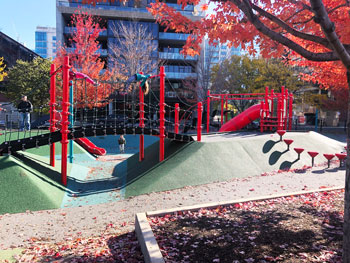
Moveable parts to promote spinning and swinging in fun new ways are also engaging and invite multigenerational play. Challenge courses can provide another opportunity for intergenerational play if done well, Spencer suggested. “A great challenge or obstacle course will offer multiple ways for a player to navigate the obstacle, so that it is suitable for a variety of skills from children to adults, thereby inviting intergenerational play, communication, skill development, teamwork and teaching/learning.”
While many people love to watch ninja shows, Spencer noted, 98% of people don’t have that level of skill, “but I’ve seen public courses that are so difficult that they are only usable by a fraction of the population, which doesn’t promote skill development and or an inclusive strategy for participation.”
Primary, secondary and observational research informs product and space designs that foster growth, development and equity for everyone, Spencer explained. “And research-based design helps us find the right information to design the right products that meet everyone’s needs and preferences. One step further from researching and using that information to design products and spaces is that we want to share that information—share the ‘why’ behind what we do,” she said. That helps everyone understand how time spent outdoors in public outdoor spaces can positively impact health, community, learning and economic outcomes, but also helps them advocate for what they need within their communities and bring play to all people.
Spencer offers Duplessis Park, in Gonzales, La., as an example of inclusive and multigenerational play.
The City of Gonzales partnered with Louisiana Economic Development to build a strategic economic development plan to enhance opportunity and quality of life for the citizens of Gonzales, Spencer explained. The development of the plan included a community assessment to solicit information from the public. As part of the goals, the city is adding a network of trails and infrastructure to promote health.
“We helped by creating a multigenerational space with fun, family-oriented fitness opportunities. There is an inclusive playground that features an accessible net structure, inclusive rocking devices and a fully accessible route of travel to and through the play space,” Spencer said.
There is also a family-centered obstacle course and 40-yard dash that encourages children, parents and grandparents to play and compete together, and a youth-focused structure that builds obstacle course skills (grip strength, traversing, climbing, etc.), so that the whole family feels included.
It’s also a National Demonstration site for inclusion and fitness, meaning the space was designed with best practices from the Research Institute at Spencer’s company’s Center for Outreach, Research and Education. “As such, the site stakeholder receives data reporting that demonstrates the site’s influence on community vitality, which is useful in defending services and demonstrating value,” Spencer said.
Awe-Inspiring
As manufacturing technologies and creative designs evolve, look for more adventure in the playspace, Liseicki said. “We continue to need to compete with screens, and adventure helps us do that. Bringing awe and adventure into our daily lives is something we’ve been studying. Daily doses of awe bring us calm and help us appreciate the world around us. Adventure play engages children and adults and has a high replay value, bringing kids and families back into the outdoors time and time again. Designing for awe and adventure is important to both our physical and mental health and helps the outdoors compete for time with screens.”
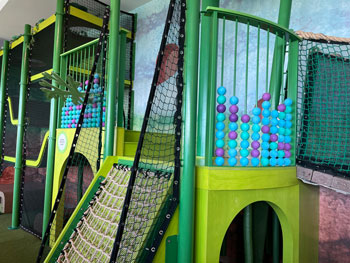
A bit of awe can improve lives and overall well-being, Liseicki contends. “Awe gets us ‘out of our heads’ and into the present, reducing feelings of self-doubt and negativity, which is especially important in the age of social media.”
The potential for awe is all around us, she said. “We can start with just spending time outside, climbing to the top of a tall tree or a play event and seeing the vastness of the space we’re in right now. Kids experience awe by discovering new things in their environments and taking the time to focus on them. Younger children can even find awe by crawling through a tunnel and coming out to a new place on the other side.”
Our bodies respond differently when we are experiencing awe than when we are feeling joy, contentment or fear, and it has huge benefits. Knowing this, Liseicki said, “we can design awe into play spaces by providing opportunities for discovery, climbing and views above the space. We can add trees and other vegetation to give kids something to wonder about and create places for them to explore. Adding in small amounts of awe can be life-changing for them, and as more research emerges, we will know even more. This is an emerging trend and research is still coming, but, whatever it means, we know awe is transformative and experiencing it on a daily basis has a positive effect on our bodies, minds and overall well-being.”
Speaking of adventure experience and “awe,” in the past few years, Roshi has seen taller towers, getting kids up higher, giving them bigger types of challenges. This increases the excitement level, so that they are eager to visit the playground because they get to climb a three-story tower. They can find places to hang out on the way to the top, and then have an exhilarating sliding experience.
“We’ve seen a significant shift in that height and it is likely to continue,” Roshi said. “Five years ago, anything higher than five feet was not even an option. And now we’ve seen multiple parks and playgrounds with three-story towers, 30-foot-tall towers.”
It’s all part of a bigger shift in playground design to allow for perceived risk, or perceived danger. One way to provide it is by “… getting kids up to these towers to a contained space where the community knows they are safe,” Roshi said. “But just the accomplishment is what excited kids about the structure. It’s about the idea of challenge, that perceived danger of heights is one of the top trends we’ve seen.
“Kids want to be challenged, and there are many more traditional types of playgrounds that don’t provide enough of that,” Roshi said.
Creating these moments encourages kids not only to stay at the playground longer, but also to come back because they might not have been able to reach the top of that tower the first time, or the third time. Giving them those types of challenges is very appealing, especially for older kids, the 7-to-12-year-olds who might get a little bored on the playground. This gives them a sense of accomplishment.
Cutting-edge as awe is, it’s not one of the six basic emotions (sadness, happiness, fear, anger, surprise and disgust), but “is its own thing.” Our bodies respond differently when we are experiencing awe than when we are feeling joy, contentment or fear, and it has huge benefits, Roshi said.
“Knowing this,” Roshi added, “we can design awe into playspaces by providing opportunities for discovery, climbing and views above the space. We can add trees and other vegetation to give kids something to wonder about and create places for them to explore.”
The Future Is Now
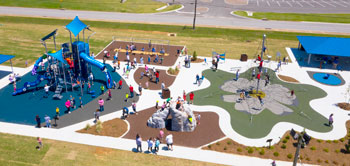
Change is being driven by advances in technology, engineering and studies by sociologists on how play affects cognitive development, Roshi said. “There are material choices that have been made, there are better manufacturing processes and tools that make some of those advances happen,” he said. “But what is key for me is that we, as a company, collaborate with occupational therapists that are part of our product development team. They help us, as we are developing a new idea. They help us to ensure that we are building something that supports somebody that might not be as strong, or that we are not over-designing it to being too far of a reach for a 5-year-old. They are also helping us to step back and look at what are the different abilities of children, from your 90th percentile, a super-adept child who can climb with the best of them, has courage and can tackle anything on the playground to a child who might be more of an introvert and is looking for more of a creative outlet, or more of an observational standpoint on the playground, where they don’t have to be actively playing to be part of the play. All of that expertise, from people like occupational therapists and childhood development specialists who we collaborate with in the design process leads to greater and greater playground designs.”
While creating a more exciting, more challenging space is one consideration when planning the layout and flow of play, it’s also important to provide the ability to escape the activity. For children on the autism spectrum or those with ADHD, this allows them to calm down and recenter themselves without leaving the playground completely, Roshi said.
As an example of that philosophy, Roshi pointed to a playground that opened a little over a year ago, at Triumph Park in Waukee, Iowa. Part of a baseball and soccer complex, the playground has high towers for children to create a great challenge, but the entire playground is designed to be very inclusive at the same time, with many sensory elements, 30-foot tall slides, spinning elements and quiet spaces. RM



